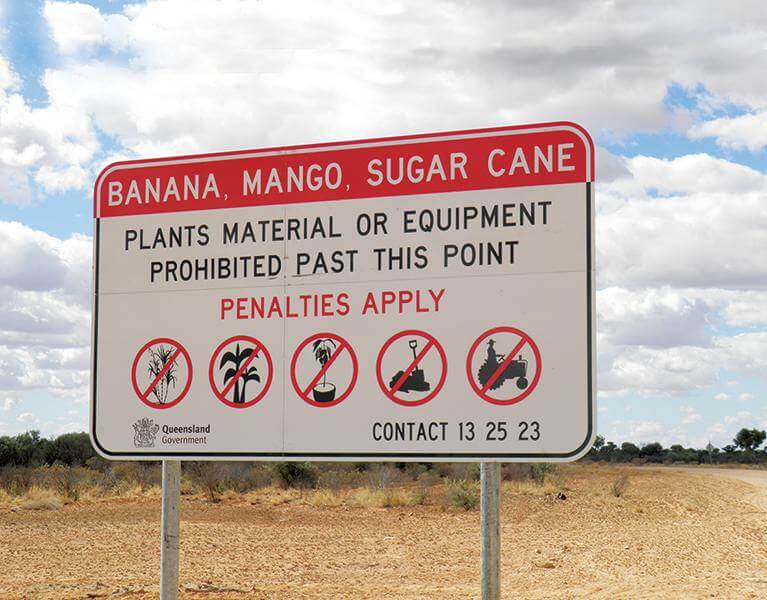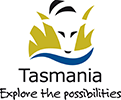 New South Wales and the Australian Capital Territory
New South Wales and the Australian Capital Territory
Banana Bunchy Top Virus Control Zone
Covers the Local Government Areas of Tweed, Lismore, Ballina and Byron. Do not move banana plants, bells, pseudo stems or leaves out of this area.
Queensland Fruit Fly Control Zone
Covers fruit production areas along the Murray River. Do not take fruit or fruiting vegetables (including capsicum, chilli, tomato and eggplant) into this area.
Phylloxera Infested Zone
Covers areas around Albury-Corowa and also areas around the Sydney basin. Do not take soil, grapevine plants, mulch or garden organics out of these areas.
Citrus Red Mite Biosecurity Zone
Established across the Central Coast region of New South Wales, including near Gosford, the County of Northumberland and Sydney metropolitan homes in the County of Cumberland. Do not move host plants including citrus plants out of this area.
Rice Biosecurity Zone
Covers most of the Murrumbidgee and Murray River regions. Do not bring rice plants or unprocessed grain such as paddy rice or brown rice into the zone. Some other rice products are also not allowed into the zone.
Seed Potato Protected Area
Covers areas around the Central Tablelands and also the Northern Tablelands. Do not bring potato planting material or soil that has been in contact with potato planting material into these areas.
PLEASE NOTE: in addition to the Seed Potato Protected Zones, the entire state of NSW is a Potato Biosecurity Zone.
The fact sheet Biosecurity Zones (external link, NSW Department of Primary Industries) includes more information about zones in NSW.
More information about the legislation related to these zones is available from the NSW Department of Primary Industries website.

Northern Territory
Movement of plant products into and/or out of the following zones is regulated
Ti Tree Fruit Fly Exclusion Zone (FFEZ)
The Ti Tree Fruit Fly Exclusion Zone extends from Tennant Creek to Alice Springs. Do not take fruit (including capsicum, chilli, tomato, eggplant, cucumber, zucchini and squash) into this zone.
Adelaide River
Restrictions apply to fruit and vegetables when travelling south from Darwin to prevent the spread of the pest melon thrips. The following produce must not be carried south along the Stuart Highway beyond the Adelaide River township: beans, capsicum, chilli, cucumber, eggplant, melons, mango fruit and mango plants (unless treated against leaf hopper), okra, pumpkin, silverbeet, squash, tomato and zucchini.

Queensland
Movement of plant products into and/or out of areas within Queensland is regulated.
The whole of the state is a biosecurity zone for bananas, grape plants, mangoes and sugarcane. Do not take any plants, soil or items that have been in contact with these plants into Queensland.
For more information about the following biosecurity zones, please contact the Queensland Department of Agriculture and Fisheries at 13 25 23 or info@daf.qld.gov.au.
External links to maps (Queensland Department of Agriculture and Fisheries)
- Banana Pest Biosecurity Zones – there are four banana biosecurity zones in relation to a number of pests and diseases of bananas
- Blueberry Rust Restricted Area
- Cape York Peninsula Pest Biosecurity Zones (two zones)
- Cercospora Leaf Spot Affected Area – in the Mareeba Shire, west of Cairns
- Electric Ant Biosecurity Zones – there are numerous biosecurity zones and movement restrictions to prevent the spread of electric ants
- Fire Ant Pest Biosecurity Zone
- Papaya Ring Spot Biosecurity Zone
- Grape Phylloxera Exclusion Zone – do not take grapes, grape vines, cuttings, budwood or soil from within 100m of a living grape vine into this zone.
- Melon Thrips North Queensland Restricted Area – areas inland and south of Cooktown, including Mossman, Cairns, Innisfail and Townville, down to Bowen
- Melon Thrips South East Queensland Restricted Area – areas inland and south of Seventeen Seventy down to the Gold Coast, including Maryborough, Nambour and Brisbane
- Sugarcane Pests Biosecurity Zone – there are six biosecurity zones related to restrictions on the movement of sugarcane products and machinery within Queensland

South Australia
Kangaroo Island
Do not take rabbits, bees or bee products onto Kangaroo island. Potatoes are also prohibited unless they have been washed or brushed free of soil and are in new packaging.
Riverland of South Australia
Do not take fresh, unprocessed fruit or fruiting vegetables (including capsicum, chilli, tomato and eggplant) into the Riverland of South Australia without a plant health certificate. A zero tolerance approach is in place and if caught with non-compliant material at the Yamba Quarantine Station or random roadblock you will be fined.
South Australian quarantine checkpoints
Quarantine stations and fruit disposal bins are strategically placed throughout South Australia. Mobile quarantine stations can operate anywhere and at anytime within South Australia.

Tasmania
Tasmanian quarantine checkpoints
Plant and animal quarantine examinations are conducted at all points of entry into Tasmania, including ferry terminals and airports. On-the-spot fines apply for both commercial and non-commercial imports.
If you own, acquire, breed or sell a cat in Tasmania new laws under the Cat Management Act 2009 apply (eg compulsory microchipping and desexing now required for cats in Tasmania).
Victoria
Movement of plant products into and/or out of the following zones is regulated.
Greater Sunraysia Pest Free Area
The Greater Sunraysia Pest Free Area (PFA) was established to protect fruit production areas along the Murray River from Queensland fruit fly. You need to apply for a permit to take fresh fruit or fruiting vegetables (including capsicum, chilli, tomato and eggplant) into the PFA. To apply for a permit contact market.access@agriculture.vic.gov.au. Note that cooked, canned, freeze-dried, dehydrated or sliced fruit & vegetables (eg salad or fruit salad) can enter the PFA with no additional requirements. Fruit disposal bins are in place in the PFA and quarantine roadblocks may operate in this zone. Signs on major roads indicate when you are entering this area.
Phylloxera Control Areas
Control areas have been established in Victoria to prevent the spread of the grapevine pest phylloxera. Signs on major roads indicate when you are entering a Phylloxera Exclusion Zone or leaving a Phylloxera Infested Zone, and that restrictions on the movement of grapevines exist for each zone.
Potato Plant Protection Districts
Potato Plant Protection Districts (PPDs) are established around some Victorian seed potato production regions in order to reduce biosecurity threats. Signs on major roads indicate when you are entering a PPD and what restrictions on potato movement apply.
Toolangi Plant Protection District
The Toolangi Plant Protection District is a protected area in which plant breeding programs are conducted. The entry of potato tubers (except those for human consumption), Rubus and Strawberry plants into this area is prohibited without a permit. To apply for a permit contact market.access@agriculture.vic.gov.au.
For more information about these zones, please contact 136 186 or visit Moving plants within Victoria (external link, Agriculture Victoria)

Western Australia
The movement of plant products into and/or out of the following zones is regulated.
Carnarvon and Kununurra banana protection areas
Only certified bananas can enter Carnarvon area. Movement of banana plants (except fruit), leaves and soil from the Canarvon area is restricted. This is to prevent the spread of banana aphids (Pentalonia nigronervosa) and Panama wilt Fusarium oxysporum f.sp. cubense (Race 1) from this area. Also, banana containers from areas infested with Panama disease (Tropical race 4) are not allowed into this area.
Movement of banana plants (except fruit), leaves and soil from the Kununurra area is restricted. This is to prevent the spread of banana weevil borer (Cosmopolites sordidus) from this area. Also, banana containers from areas infested with Panama disease (Tropical race 4) are not allowed into this area.
Kimberley region
There are restrictions on the entry of nursery stock, cut flowers and foliage, and leafy vegetables into the Kimberley division. This is to reduce the risk of introducing silverleaf whitefly (Bemisia tabaci B biotype).
Ord River Irrigation Area
Uncertified citrus and stone fruit are not allowed into the Ord River Irrigation Area (Kununurra) from 1 April to 30 November each year. This is to reduce the risk of introducing Mediterranean fruit fly (Ceratitis capitata) into this area.
Uncertified cut flowers, foliage and leafy vegetables are not allowed out of the Ord River Irrigation Area (Kununurra) unless certified. This is to reduce the risk of spreading melon thrips (Thrips palmi).
Broome area
Uncertified palm plants and foliage are not allowed out of the Broome area. This is to prevent the spread of palm leaf beetle (Brontispa longissima) from this area.
Gin Gin and South-west
Potatoes imported into Western Australia from another state or territory (except Tasmania) are not allowed into these potato growing areas of the state. This is to protect against the introduction of potato cyst nematode (Globodera rostochiensis).

 New South Wales and the Australian Capital Territory
New South Wales and the Australian Capital Territory












